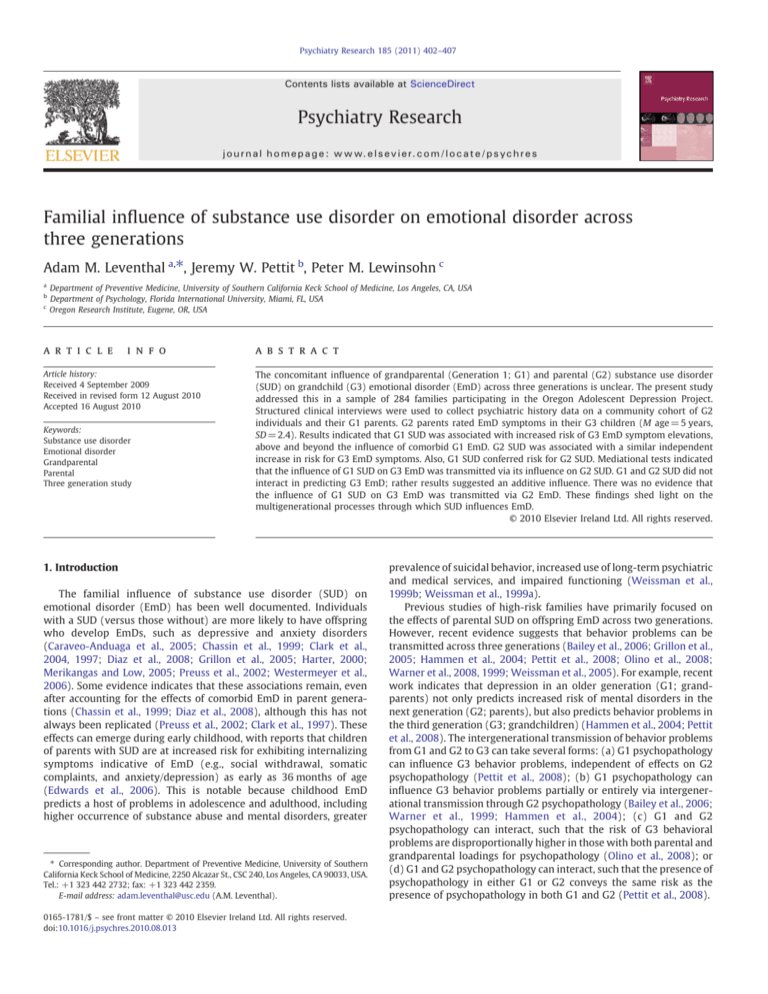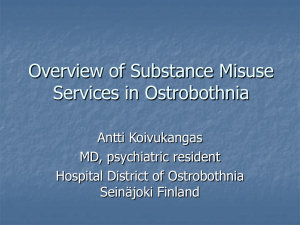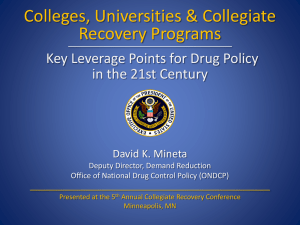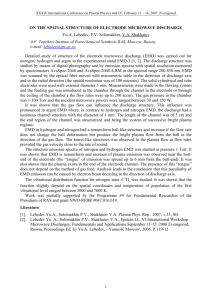
Psychiatry Research 185 (2011) 402–407
Contents lists available at ScienceDirect
Psychiatry Research
j o u r n a l h o m e p a g e : w w w. e l s ev i e r. c o m / l o c a t e / p s yc h r e s
Familial influence of substance use disorder on emotional disorder across
three generations
Adam M. Leventhal a,⁎, Jeremy W. Pettit b, Peter M. Lewinsohn c
a
b
c
Department of Preventive Medicine, University of Southern California Keck School of Medicine, Los Angeles, CA, USA
Department of Psychology, Florida International University, Miami, FL, USA
Oregon Research Institute, Eugene, OR, USA
a r t i c l e
i n f o
Article history:
Received 4 September 2009
Received in revised form 12 August 2010
Accepted 16 August 2010
Keywords:
Substance use disorder
Emotional disorder
Grandparental
Parental
Three generation study
a b s t r a c t
The concomitant influence of grandparental (Generation 1; G1) and parental (G2) substance use disorder
(SUD) on grandchild (G3) emotional disorder (EmD) across three generations is unclear. The present study
addressed this in a sample of 284 families participating in the Oregon Adolescent Depression Project.
Structured clinical interviews were used to collect psychiatric history data on a community cohort of G2
individuals and their G1 parents. G2 parents rated EmD symptoms in their G3 children (M age = 5 years,
SD = 2.4). Results indicated that G1 SUD was associated with increased risk of G3 EmD symptom elevations,
above and beyond the influence of comorbid G1 EmD. G2 SUD was associated with a similar independent
increase in risk for G3 EmD symptoms. Also, G1 SUD conferred risk for G2 SUD. Mediational tests indicated
that the influence of G1 SUD on G3 EmD was transmitted via its influence on G2 SUD. G1 and G2 SUD did not
interact in predicting G3 EmD; rather results suggested an additive influence. There was no evidence that
the influence of G1 SUD on G3 EmD was transmitted via G2 EmD. These findings shed light on the
multigenerational processes through which SUD influences EmD.
© 2010 Elsevier Ireland Ltd. All rights reserved.
1. Introduction
The familial influence of substance use disorder (SUD) on
emotional disorder (EmD) has been well documented. Individuals
with a SUD (versus those without) are more likely to have offspring
who develop EmDs, such as depressive and anxiety disorders
(Caraveo-Anduaga et al., 2005; Chassin et al., 1999; Clark et al.,
2004, 1997; Diaz et al., 2008; Grillon et al., 2005; Harter, 2000;
Merikangas and Low, 2005; Preuss et al., 2002; Westermeyer et al.,
2006). Some evidence indicates that these associations remain, even
after accounting for the effects of comorbid EmD in parent generations (Chassin et al., 1999; Diaz et al., 2008), although this has not
always been replicated (Preuss et al., 2002; Clark et al., 1997). These
effects can emerge during early childhood, with reports that children
of parents with SUD are at increased risk for exhibiting internalizing
symptoms indicative of EmD (e.g., social withdrawal, somatic
complaints, and anxiety/depression) as early as 36 months of age
(Edwards et al., 2006). This is notable because childhood EmD
predicts a host of problems in adolescence and adulthood, including
higher occurrence of substance abuse and mental disorders, greater
⁎ Corresponding author. Department of Preventive Medicine, University of Southern
California Keck School of Medicine, 2250 Alcazar St., CSC 240, Los Angeles, CA 90033, USA.
Tel.: +1 323 442 2732; fax: +1 323 442 2359.
E-mail address: adam.leventhal@usc.edu (A.M. Leventhal).
0165-1781/$ – see front matter © 2010 Elsevier Ireland Ltd. All rights reserved.
doi:10.1016/j.psychres.2010.08.013
prevalence of suicidal behavior, increased use of long-term psychiatric
and medical services, and impaired functioning (Weissman et al.,
1999b; Weissman et al., 1999a).
Previous studies of high-risk families have primarily focused on
the effects of parental SUD on offspring EmD across two generations.
However, recent evidence suggests that behavior problems can be
transmitted across three generations (Bailey et al., 2006; Grillon et al.,
2005; Hammen et al., 2004; Pettit et al., 2008; Olino et al., 2008;
Warner et al., 2008, 1999; Weissman et al., 2005). For example, recent
work indicates that depression in an older generation (G1; grandparents) not only predicts increased risk of mental disorders in the
next generation (G2; parents), but also predicts behavior problems in
the third generation (G3; grandchildren) (Hammen et al., 2004; Pettit
et al., 2008). The intergenerational transmission of behavior problems
from G1 and G2 to G3 can take several forms: (a) G1 psychopathology
can influence G3 behavior problems, independent of effects on G2
psychopathology (Pettit et al., 2008); (b) G1 psychopathology can
influence G3 behavior problems partially or entirely via intergenerational transmission through G2 psychopathology (Bailey et al., 2006;
Warner et al., 1999; Hammen et al., 2004); (c) G1 and G2
psychopathology can interact, such that the risk of G3 behavioral
problems are disproportionally higher in those with both parental and
grandparental loadings for psychopathology (Olino et al., 2008); or
(d) G1 and G2 psychopathology can interact, such that the presence of
psychopathology in either G1 or G2 conveys the same risk as the
presence of psychopathology in both G1 and G2 (Pettit et al., 2008).
A.M. Leventhal et al. / Psychiatry Research 185 (2011) 402–407
Extant data supports each of these potential pathways for the
transmission of several forms of behavioral problems across three
generations (Bailey et al., 2006; Grillon et al., 2005; Hammen et al.,
2004; Pettit et al., 2008; Olino et al., 2008; Warner et al., 2008, 1999;
Weissman et al., 2005). However, it remains unclear whether SUD
influences risk of EmD across three generations, and how this familial
risk pathway may be transmitted from G1 to G2 to G3. Studying the
tri-generational effects of SUD on EmD is important for: (a) clarifying
the mechanisms by which family history of SUD enhances vulnerability to EmD; (b) identifying high-risk families who may benefit most
from preventive interventions; (c) elucidating whether interventions
which target G2 SUD may (or may not) potentially disrupt the effects
of G1 SUD on G3 EmD; and (d) ascertaining whether researchers and
clinicians should obtain extended family pedigrees to evaluate risk in
children.
There are several reasons why G1 SUD may increase risk of G3
EmD. Given that SUD and EmD potentially share overlapping genetic
variance (Tambs et al., 1997; Prescott et al., 2000; Kendler et al.,
1993), grandparents with SUD may transmit genetic vulnerability to
EmD to their children, who may in turn transmit this genetic
susceptibility to their offspring. Environmental factors may also play
a role. Offspring of parents with SUD are at substantial risk of
developing SUD when they enter into adulthood (Merikangas et al.,
1998). Thus, when these offspring become parents themselves, they
are likely to have a SUD. Evidence suggests that parents with SUD are
more likely to engage in dysfunctional parenting practices which may
mediate the link between parental SUD and child EmD (Edwards et al.,
2006). Thus, the influence of G1 SUD on G3 EmD may be transmitted
through G2 SUD because G3 offspring may be subject to considerable
environmental risk in having a G2 parent with SUD.
The current study examined the familial influence of SUD on EmD
across three generations. Because multiple forms of SUD have familial
links with both the mood and anxiety disorders (Clark et al., 2004;
Diaz et al., 2008) and there has been little specificity in familial
clustering of subtypes of EmD in young children (Merikangas and
Low, 2005), this initial analysis focused on the effect of any type of
SUD on any type of EmD. The data for this report were collected from
the Oregon Adolescent Depression Project (OADP), a longitudinal
study of mental disorders that followed a community cohort of
adolescents into adulthood (G2) that was later expanded to include
assessment of the cohort's parents (G1) and their children (G3). In a
previous analysis of subsample of the OADP, Olino et al. (2008) found
that neither G1 nor G2 SUD predicted internalizing symptoms among
162 G3 grandchildren when they were 24 months of age. However,
one study suggests that offspring of parents with SUDs may not
exhibit elevated internalizing symptoms until 36 months of age
(Edwards et al., 2006). In addition, Olino et al.'s analysis did not
clarify how the risk carried by G1 and G2 SUD status may either
overlap or interact to influence vulnerability to EmD among G3
offspring.
The current report addressed these issues using an expanded sample
of 284 families who participated in the OADP. G3 grandchildren were
aged 2 to 10 years-old (mean age of 5 years old). Given the potential
genetic and environmental factors that may play a role within families
across three generations, we hypothesized that G1 SUD would be
associated with increased risk of elevated levels of EmD symptoms in G3
and that this association would be transmitted via G2 SUD. Therefore, we
examined the influence of G1 SUD on G3 EmD symptoms, relevant
intermediate familial links between G1 SUD and G3 EmD (i.e., G1
SUD→G2 SUD; G1 SUD→G2 EmD; G2 SUD→G3 EmD), and mediational
models that tested whether the effects of G1 SUD on G3 EmD symptom
elevations were carried by G2 SUD. We also investigated whether G1 and
G2 SUD interacted to predict G3 EmD symptoms. Because previous
research demonstrating interactive effects of G1 and G2 diagnostic status
on grandchild outcomes have been mixed in the depression literature
(Olino et al., 2008; Pettit et al., 2008; Weissman et al., 2005), we did not
403
make any a priori hypotheses regarding the interactive effects of G1 and
G2 SUD status.
2. Methods
2.1. Sampling strategy
2.1.1. G2 parents
Original OADP probands, who will be referred to as “G2” in this report, were
randomly selected from nine high schools in western Oregon to be representative of the
region. A total of 1709 sixteen-year-old adolescents (91.1% Caucasian) completed an
initial (T1) psychiatric assessment between 1987 and 1989. The T1 participation rate
was 61%. Approximately one year later, 1507 (53.7% female; 91.8% Caucasian) returned
for a second evaluation (T2). Differences between the sample and the larger population
from which it was selected, and between participants and those who declined or
dropped out before T2, were small (Lewinsohn et al., 1993). At age 24, all probands
with a history of Axis I psychiatric disorders and a random sample of probands with no
history of psychopathology by T2 (n = 457) were invited to a third (T3) evaluation. Of
the 1101 probands selected for a T3 interview, 941 (57.3% female; 90.4% Caucasian)
completed the evaluation. T2 diagnostic groups did not differ on the rate of
participation at T3. At age 30, all T3 probands were invited to a T4 evaluation. Of the
941 T3 probands, 816 (59.3% female; 89.2% Caucasian) completed the T4 diagnostic
interview. Among those invited to T3 and T4 assessments, women were more likely
than men to complete evaluations, Χ2 N 5.99, ps b .05; participation did not differ as a
function of other status variables or previous diagnoses.
2.1.2. G3 grandchildren
Probands with children were asked to complete the Child Behavior Checklist
(CBCL: Achenbach, 1991, 1992) parent ratings on their biological children (G3) near the
time of the T3 interview, annually for up to seven years, and then again at T4. Out of the
total 816 probands with data available, at least one CBCL rating was completed for
biological children of 337 (41.3%) probands, who ranged in age from 2 to 18 years old.
No Axis I diagnostic status differed as a function of proband parental status.
2.1.3. G1 grandparents
We assessed lifetime psychopathology in both of the biological parents (G1) of
probands near the time of the T3 evaluation. Of the 337 G2 probands with available
child data, 294 (87.2%) also had available data on G1 diagnostic status. Cases with
missing G1 data (n = 43, 12.8%) did not significantly differ from other cases on any
measured variable.
2.1.4. Reference sample for the present report
As indicated above, all three generations of diagnostic data were available for 294
G2 probands, their G3 children, and both of their G1 parents. Of these 294 families, two
cases in which G3 CBCL ratings were collected prior to G2 SUD onset were eliminated
because of difficulty discerning temporal precedence of disorder onset across
generations. Examination of the distribution of G3 ages indicated a natural break in
the data in which only 8 cases were aged 11 to 18 years old. Thus, to reduce
heterogeneity due to puberty and adolescent developmental processes, these cases
were eliminated. The final dataset included 284 families (see demographic data for
each generation in Table 1).
After a description of the study, written informed consent was obtained from G1
and G2 participants, and they were remunerated for their participation. This research
was approved by an Institutional Review Board.
2.2. Measures
2.2.1. G2 parents
At T1, G2 probands were interviewed with a version of the Schedule for Affective
Disorders and Schizophrenia for School-Age Children (Orvaschel et al., 1982), which
included additional items to derive DSM-III-R diagnoses. At following assessment
waves, probands were interviewed using the Longitudinal Interval Follow-up
Evaluation (Keller et al., 1987), which elicited detailed information about the onset
and course of psychiatric disorders since the previous evaluation.
2.2.2. G3 grandchildren
CBCL ratings of G3 children were completed by G2 probands at up to eight
assessment points. Only G3 children born at least two years prior to the first CBCL
administration were eligible for all eight ratings; the majority of G3 children were born
during the course of the CBCL administrations. On average, 1.91 CBCL ratings were
completed for each child, with 121 grandchildren being rated only once, 72 receiving
two ratings, 86 receiving three ratings, and 5 receiving four or more ratings. For G3
children with multiple CBCL ratings, the rating with the highest Internalizing Scale
score was selected in order to increase statistical power and to make G3 diagnoses
consistent with our lifetime diagnostic approach used with G2 and G3 (Pettit et al.,
2008; Olino et al., 2008). As in our prior reports (Pettit et al., 2008; Olino et al., 2008),
we included ratings only for firstborn children in families with 2 or more G3 children to
reduce potential biases associated with birth order and to increase the mean age of G3.
Mean age of G3 children at the time of the CBCL rating was 4.74 (SD = 2.43) years
(range: 2–10).
404
A.M. Leventhal et al. / Psychiatry Research 185 (2011) 402–407
The CBCL 2–3 (for children aged 2–3 years: Achenbach, 1992) consists of 99 items
and the CBCL 4–18 (for children aged 4–18 years: Achenbach, 1991) consists of 113
items. Items are rated on a 3-point scale, corresponding to whether the behavior is not
true, somewhat/sometimes true, or very true/often true of the target child. The CBCL
factor structure consists of eight narrow-band problem scales and two broadband
scales, Internalizing Problems and Externalizing Problems.
2.2.3. G1 grandparents
G1 grandmother and grandfathers were directly interviewed once using a version
of the nonpatient edition of the Structured Clinical Interview for DSM-III-R that had
been modified for DSM-IV criteria (Spitzer et al., 1992). Interviewers were unaware of
probands' diagnoses. To ensure that some diagnostic data were available even for the
portion of G1 participants who were not personally interviewed and to supplement the
direct interviews, family history data on G1 were collected using the Family Informant
Schedule and Criteria (FISC: Manuzza and Fyer, 1990), supplemented with items to
derive DSM-IV diagnoses. The FISC was administered to the G2 probands and at least
one first-degree relative from each family. Best estimate DSM-IV diagnoses (Leckman,
1982) were derived for G1 participants using all available data by two senior
diagnosticians. Statistical controls for direct vs. informant interview status had no
meaningful impact on any analysis.
2.3. Diagnostic classifications for the present report
G1 EmD status was rated positive if at least one grandparent had a lifetime history
of any mood or anxiety disorder. Similarly, G1 SUD status was rated positive if at least
one grandparent had a lifetime history of any alcohol or drug abuse or dependence
diagnosis, other than nicotine. As with previous reports (Pettit et al., 2008; Olino et al.,
2008), we selected this approach rather than examining the effects of grandmother and
grandfather diagnostic status separately to increase power to detect effects.1 G2 SUD or
EmD status was rated positive if the proband had a lifetime history of the respective
class of disorder across data collected from all 4 assessments. Independent review of
randomly-selected audiotapes revealed moderate-to-excellent interrater reliability for
SUD, mood disorder, and anxiety disorder diagnoses of G1 and G2 (Kappas .69 to .85:
Pettit et al., 2008). The lifetime prevalence of psychiatric disorders outside of the EmDs
and SUDs (e.g., psychotic disorders, eating disorders) in this sample was very low. For
G1, there were 3 cases of eating disorders, 1 psychotic disorder, and 12 cases of
disruptive behavior disorders (i.e., conduct disorder, oppositional defiant disorder, and
attention deficit/hyperactivity disorder). For G2, there were 5 cases of eating disorders,
0 psychotic disorders, and 11 disruptive behavior disorders. None of these disorders for
G1 or G2 were significantly associated with G3 EmD and were therefore not included as
covariates in analyses (see Data analysis section).
G3 participants were rated positive for EmD symptoms if they demonstrated a
borderline or clinical elevation (T-score N 60: Achenbach, 1992) on the Internalizing
scale, which measures various symptoms of childhood emotional disturbance (Social
Withdrawal, Somatic Complaints, and Anxiety/Depression). Children above this cutoff
score in the top 16% of the normative sample (Achenbach, 1992). Using this cutoff is
consistent with recommendations (Achenbach, 1992) and demonstrates good
concordance with DSM-based diagnoses of current (Keenan et al., 1997) and future
(Mesman and Koot, 2001) EmD.
2.4. Data analysis
The primary approach involved conducting logistic regression analysis to examine
whether SUD status predicted EmD status across generations (G1 to G2 to G3). To
examine each relevant link from G1 SUD to G3 EmD status, four sets of logistic
regression models were tested: (1) G1 SUD predicting G3 EmD; (2) G2 SUD predicting
G3 EmD; (3) G1 SUD predicting G2 EmD; and (4) G1 SUD predicting G2 SUD. For each
set of models, Model A included only the primary predictor, Model B added any
demographic variable that was associated with the primary predictor and the outcome
variable as a covariate (i.e., G3 age at CBCL rating for analyses predicting G3 EmD; G2
gender for analyses predicting G2 SUD/EmD), and Model C added the older generation's
EmD status as a covariate to examine whether any intergenerational effect of SUD was
specific or explained by within-generation SUD-EmD comorbidity. The third set of
models examining if G1 SUD predicted G2 EmD also included a Model D that added G2
SUD as a covariate. Similarly, the fourth set of models examining if G1 SUD predicted G2
SUD also included a Model D that added G2 EmD as a covariate. These additional
models help to disentangle overlap between EmD and SUD at the G2 generation.
To examine whether the effect of G1 SUDs on G3 EmD symptoms was transmitted
through effects on G2 SUD, we re-assessed the initial models to see if the conditions for
mediation were met (i.e., G1 SUD → G3 EmD, G1 SUD → G2 SUD, G2 SUD → G3 EmD)
1
To explore the potential influence of having 1 vs. 2 grandparents with SUDs, we
compared rates of G3 EmDs between offspring of these two groups. Results showed
that 18% of G3 offspring with 1 grandparent with SUD were positive for EmD, and 10%
of offspring with 2 grandparents with SUDs were positive for EmD. These rates were
not significantly different. Thus, the primary analyses use a binary classification of G1
SUD status, with a positive rating indicating at least one grandparent had a lifetime
SUD.
Table 1
Sociodemographic characteristics of each generation.
Variable
G1 (n = 284 dyads)
Grandfathers (n = 284)
Age, M (SD)
Married, n (%)
Caucasian, n (%)
Grandmothers (n = 284)
Age, M (SD)
Married, n (%)
Caucasian, n (%)
G2 (n = 284)
Age, M (SD)
Female, n (%)
Married, n (%)
Caucasian, n (%)
G3 (n = 284)
Age at highest CBCL internalizing score, M (SD)
Female, n (%)
50.69 (5.47)
199 of 227 (87.7%)a
209 of 223 (93.7%)a
48.71 (4.37)
196 (69.0%)
255 (89.8%)
27.38
186
195
250
(2.72)
(65.5%)
(69.4%)
(88.0%)
4.74 (2.43)
143 (50.4%)
G1 = grandparental generation; G2 = parental generation; G3 = grandchild generation.
a
Information on marital status and race was not provided for approximately 60 G1
grandfathers.
and then examined the significance of the indirect effect by performing a PRODCLIN
asymmetric confidence intervals test (Fritz and MacKinnon, 2007; MacKinnon et al.,
2008). PRODCLIN provides a product-of-coefficient test that does not rely on normal
theory. It is a variation of the Sobel test that accounts for a non-normal distribution of
the product term through the construction of asymmetric confidence intervals. Prior
research suggests that PRODCLIN provides a more statistically powerful test and results
in more accurate Type I error rates than other commonly-used mediation tests
(MacKinnon et al., 2008).
To evaluate the concurrent and interactive effects of G1 and G2 SUD on G3 EmD, we
tested a fifth set of models in which G1 SUD and G2 SUD were entered as simultaneous
predictors (Model A), G3 age was added (Model B), G1 and G2 EmD were added (Model
C), and the G1 SUD × G2 SUD interaction was added (Model D).
Results are reported as odds ratios (ORs) with 95% confidence intervals (CIs). All
tests were two-tailed and statistical significance was set at .05.
3. Results
3.1. Prevalence of SUD and EmD
Of the total 284 G2 probands in this report, 157 (55.2%) had at least
one G1 parent with a lifetime history of SUD. Similarly, 156 (54.9%) had at
least one G1 parent with lifetime EmD. Within G2, 114 (40.1%) and 187
(65.8%) probands were positive for lifetime SUD and EmD, respectively.
In G3, 39 (13.7%) firstborn children of G2 probands were positive for EmD
in their highest CBCL Internalizing score rating and were therefore coded
positive for G3 EmD status.
3.2. Are there linkages between G1 SUD and G3 EmD
symptom elevations?
Prevalence rates of EmD and SUD, by parental and grandparental SUD
status are presented in Table 2. Results of logistic regression analyses are
reported in Table 3.
3.2.1. G1 SUD predicting G3 EmD symptoms
Positive G1 SUD status significantly predicted increased risk of G3
EmD symptom elevations with and without adjusting for covariates (see
prevalence rates in Table 2 and Model Set 1 in Table 3).
3.2.2. G2 SUD predicting G3 EmD symptoms
Positive G2 SUD significantly predicted increased risk of G3 EmD
symptom elevations with and without adjusting for covariates (Table 3;
Model Set 2).
A.M. Leventhal et al. / Psychiatry Research 185 (2011) 402–407
Table 2
Prevalence rates of EmD and SUD, by parental and grandparental SUD status.
G1 SUD statusa
G3 EmD, n (%)
G2 EmD, n (%)
G2 SUD, n (%)
G2 SUD statusb
SUD(n = 127)
SUD +
(n = 157)
SUD(n = 170)
SUD +
(n = 114)
11 (8.7%)
80 (63.0%)
40 (31.5%)
28 (17.8%)
107 (68.2%)
74 (47.1%)
16 (9.4%)
23 (20.2%)
Total N = 284. SUD = Substance Use Disorder; EmD = Emotional Disorder; G1 =
grandparental generation; G2 = parental generation; G3 = grandchild generation.
a
Rated positive (+) if at least one grandparent has a lifetime history of SUD, and
rated negative (−) if neither grandparent has lifetime history of SUD.
b
Rated positive if G2 proband has lifetime history of SUD.
3.2.3. G1 SUD predicting G2 EmD
Positive G1 SUD status did not significantly predict increased risk
of G2 EmD (Table 3; Model Set 3).
3.2.4. G1 SUD predicting G2 SUD
Positive G1 SUD status significantly predicted increased risk of G2
SUD with and without adjusting for covariates (Table 3; Model Set 4).
3.3. Is the influence of G1 SUD on G3 EmD symptoms transmitted
through effects on G2 SUD?
As indicated above, G1 SUD predicted G3 EmD symptoms. Furthermore, G1 SUD predicted G2 SUD and G2 SUD predicted G3 EmD
symptoms. Therefore, the initial conditions of mediation were met. To
test whether the influence of G1 SUD on G3 EmD symptoms was
transmitted indirectly through effects on G2 SUD, a mediation analysis
was conducted using the PRODCLIN asymmetric confidence intervals
test. The PRODCLIN test indicated that the 95% confidence interval of the
product term did not overlap with zero: lower limit =.0569, upper
limit=1.442. This result therefore indicates an indirect effect of G1 SUD
on G3 EmD via G2 SUD.
In a combined model which included G1 SUD and G2 SUD as
simultaneous predictors of G3 EmD symptoms, the effect of G1 SUD
was reduced to a non-significant trend, and the effect of G2 SUD was
significant (Table 3; Model Set 5, Model A). This pattern of results was
consistent after adjusting for relevant covariates (Table 3; Model Set
5, Models B and C). Overall, these results indicate that the effects of G1
SUD on G3 EmD were partially (but not entirely) transmitted through
G2 SUD. In addition, the remaining trend-level effects of G1 and
significant effects of G2 SUD are indicative of non-overlapping,
additive effects on G3 EmD to some degree.
3.4. Do G1 SUD and G2 SUD interact to predict G3 EmD symptoms?
In the model which included the G1 SUD× G2 SUD interaction term,
the interaction was non-significant (Table 3; Model Set 5, Model D).
4. Discussion
This study found that grandchildren who had at least one grandparent
with a history of SUD were at greater than two-fold increase in risk for
elevated levels of EmD symptoms, indicating that the familial effects of
SUD on EmD may span three generations. Results from mediational
analyses indicated that this effect was partially transmitted via increased
prevalence of G2 SUD. There was not an interactive effect between G1
SUD and G2 SUD on risk of G3 EmD symptoms.
These results add to previous data supporting familial transmission of
behavioral problems across three generations (Bailey et al., 2006; Grillon
et al., 2005; Hammen et al., 2004; Pettit et al., 2008; Olino et al., 2008;
Warner et al., 2008, 1999; Weissman et al., 2005), and extend them to the
SUD-EmD link. Previous work has found that G1 depression predicts G3
anxiety (Weissman et al., 2005; Warner et al., 1999), G1 depression
405
predicts G3 internalizing symptoms (Pettit et al., 2008; Hammen et al.,
2004), G1 depression predicts G3 externalizing symptoms and disruptive
behavior disorders (Warner et al., 1999; Pettit et al., 2008), and G1
substance use predicts G3 externalizing behavior (Bailey et al., 2006). To
our knowledge, this was the first study to find evidence that the familial
influence of SUD on EmD symptoms spans three generations. This result
is in contrast of Olino et al. (2008), which did not find an influence of G1
SUD on G3 EmD symptoms in 166 OADP families with G3 grandchildren
assessed at 24 months of age. In the current study, the sample was
expanded to 284 families and the average age at G3 assessment was
5 years (range 2–10 years). The discordant findings across these
investigations could be due to: (a) the greater statistical power provided
by the larger sample; or (b) the possibility that risk for EmD that is carried
by grandparental SUD may not be manifested until later in childhood.
Indeed, a recent longitudinal study found that increased risk of EmD
symptoms due to parental SUD was not expressed when offspring were
18 and 24 months of age, but was present when offspring reached
36 months of age (Edwards et al., 2006). However, the question of
whether tri-generational effects of SUD on EmD differ between children
who are older versus younger than 36 months of age remains an
empirical question that should be addressed in future work.
Results revealed several intermediate intergenerational links
between G1 SUD and G3 EmD symptom elevations, including G1
SUD → G2 SUD and G2 SUD → G3 EmD. Each of these linkages
remained significant when adjusting for comorbid EmD within the
older generation and relevant demographic variables. This raised the
possibility that the effects of G1 SUD on G3 EmD could be transmitted
via G2 SUD. A test of this hypothesis using meditational modeling
yielded a statistically significant result, which indicates that the
influence of grandparental SUD on grandchild EmD was transmitted
through parental SUD. This finding is consistent with a previous study
demonstrating that the influence of G1 substance use on G3
externalizing behavior was partially transmitted via G2 substance
use (Bailey et al., 2006).
Unexpectedly, there was no evidence of an intermediate link from
G1 SUD to G2 EmD, suggesting that G2 EmD did not transmit the
effects of G1 SUD on G3 EmD symptom elevations. Although the
direction of the OR in the model predicting G2 EmD from G1 SUD
indicated an increase in risk, this effect was not statistically
significant. This finding is in contrast with previous reports documenting a two-generation familial effect of SUD on EmD (e.g., Clark
et al., 2004) and the current finding that G2 SUD predicted G3 EmD
symptom elevations. Although a similar pattern has been demonstrated previously (e.g., Baily et al. demonstrated that the effects of G1
substance use on G3 externalizing behavior were stronger than the
corresponding effects of G1 substance use on G2 externalizing
behavior), the meaning of this finding is currently unclear.
We found no evidence of an interaction between G1 SUD and G2
SUD in predicting G3 EmD symptoms. The lack of interaction along
with evidence that G1 SUD and G2 SUD had significant (or nearsignificant) unique effects on G3 EmD symptoms in combined models
suggests that the risk of child EmD may increase with the presence of
SUD in prior generations in an additive manner. This is in contrast
with previous reports of interactive intergenerational effects in the
depression literature, such that having two (versus one) generations
of familial loading for depression results in a non-additive, disproportionate change in risk of EmD (Olino et al., 2008; Pettit et al., 2008;
Weissman et al., 2005).
This study had several limitations. We were unable to obtain
diagnostic information on all G1 and G2 participants. We relied on a
single index of EmD in G3 children–parent report on the CBCL
Internalizing scale. This measure does not indicate an EmD diagnosis
per se; rather, it assesses symptoms indicative of EmD, which should be
considered when interpreting the present findings. Although statistical
control of comorbid EmD in G2 analyses predicting G3 EmD potentially
limited the degree to which mood state may have biased parental
406
A.M. Leventhal et al. / Psychiatry Research 185 (2011) 402–407
Table 3
Results of logistic regression models.
Predictors
Model A
Model B
Model C
Model D
Model set 1 (outcome: G3 EmD)
G1 SUD, OR (95% CI)
G3 age, OR (95% CI)
G1 EmD, OR (95% CI)
Overall Model Statistics
2.34 (1.05, 5.21)⁎
–
–
χ2 = 4.70⁎, R2 = 0.02
2.26 (1.00, 5.09)⁎
1.24 (1.07, 1.43)⁎⁎
–
Δχ2 = 8.79⁎⁎, ΔR2 = 0.03
2.26 (1.00, 5.14)⁎
1.24 (1.07, 1.43)⁎⁎
0.99 (0.47, 2.10)
Δχ2 = 0.01, ΔR2 b 0.01
N/A
N/A
N/A
N/A
Model set 2 (outcome: G3 EmD)
G2 SUD, OR (95% CI)
G3 age, OR (95% CI)
G2 EmD, OR (95% CI)
Overall Model Statistics
2.43 (1.22, 4.84)⁎
–
–
χ2 = 6.53⁎, R2 = 0.02
2.36 (1.17, 4.73)⁎
1.19 (1.04, 1.36)⁎
–
Δχ2 = 6.00⁎, ΔR2 = 0.02
2.03 (1.00, 4.15)⁎
1.18 (1.03, 1.36)⁎
2.22 (0.92, 5.38)
Δχ2 = 3.48†, ΔR2 = 0.01
N/A
N/A
N/A
N/A
Model set 3 (outcome: G2 EmD)
G1 SUD, OR (95% CI)
G2 gender, OR (95% CI)
G1 EmD, OR (95% CI)
G2 SUD, OR (95% CI)
Overall Model Statistics
1.26 (0.77, 2.06)
–
–
–
χ2 = 0.83, R2 b 0.01
1.34 (0.80, 2.25)
0.26 (0.15, 0.44)⁎⁎⁎
–
–
Δχ2 = 26.36⁎⁎⁎, ΔR2 = 0.09
1.25 (0.74, 2.12)
0.26 (0.15, 0.43)⁎⁎⁎
1.83 (1.08, 3.10)⁎
–
Δχ2 = 5.18⁎, ΔR2 = 0.02
1.07 (0.62, 1.85)
0.18 (0.10, 0.33)⁎⁎⁎
1.84 (1.07, 3.17)⁎
3.68 (1.98, 6.83)⁎⁎⁎
Δχ2 = 19.13⁎⁎⁎, ΔR2 = .07
Model set 4 (outcome: G2 SUD)
G1 SUD, OR (95% CI)
G2 gender, OR (95% CI)
G1 EmD, OR (95% CI)
G2 EmD, OR (95% CI)
Overall Model Statistics
1.94 (1.19, 3.16)⁎⁎
–
–
–
χ2 = 7.22⁎⁎, R2 = 0.03
1.94 (1.18, 3.18)⁎⁎
1.98 (1.20, 3.29)⁎⁎
–
–
Δχ2 = 7.11⁎⁎, ΔR2 = 0.03
1.92 (1.17, 3.16)⁎⁎
1.99 (1.20, 3.29)⁎⁎
1.08 (0.66, 1.77)
–
Δχ2 = 0.09, ΔR2 b 0.01
1.92 (1.15, 3.22)⁎
3.19 (1.78, 5.74)⁎⁎⁎
0.93 (0.55, 1.55)
3.78 (2.02, 7.06)⁎⁎⁎
Δχ2 = 19.60⁎⁎⁎, ΔR2 = .07
Model set 5 (outcome: G3 EmD)
G1 SUD, OR (95% CI)
G2 SUD, OR (95% CI)
G3 age, OR (95% CI)
G1 EmD, OR (95% CI)
G2 EmD, OR (95% CI)
G1 SUD × G2 SUD, OR (95% CI)
Overall Model Statistics
2.05 (0.91, 4.64)†
2.45 (1.16, 5.18)⁎
–
–
–
–
χ2 = 10.38⁎⁎, R2 = 0.02
2.00 (0.89, 4.57)†
2.43 (1.13, 5.20)⁎
1.24 (1.07, 1.43)⁎⁎
–
–
–
Δχ2 = 8.40⁎⁎, ΔR2 = 0.03
2.02 (0.87, 4.72)†
2.16 (1.00, 4.72)⁎
1.24 (1.07, 1.43)⁎⁎
0.88 (0.41, 1.91)
1.79 (0.71, 4.53)
–
Δχ2 = 1.62, ΔR2 b 0.01
2.20 (0.64, 7.60)
2.43 (0.59, 10.01)
1.23 (1.07, 1.43)⁎⁎
0.88 (0.41, 1.92)
1.78 (0.70, 4.51)
0.85 (0.16, 4.52)
Δχ2 = 0.04, ΔR2 b 0.01
Total N = 284. Dash indicates that predictor was not included in model. N/A = not applicable. SUD = substance use disorder; EmD = emotional disorder; G1 = grandparental
generation; G2 = parental generation; G3 = grandchild generation.
†
p b 0.10.
⁎ p b 0.05.
⁎⁎ p b 0.01.
⁎⁎⁎ p b 0.001.
ratings of children adjustment, future analyses should extend these
findings to non-parental informants and other assessment methods
(Grillon et al., 2005). Because only a portion G2 participants with no
history of psychopathology at T2 were invited to be reassessed as part of
the T3 evaluation, a larger than normal proportion of G2 probands had
psychopathology, which may have increased the rates of psychopathology in G1 and G3 generations. As a result, this sample may not be
representative of the general population. Different tools were used to
assess EmD and SUDs for G1, G2, and G3, which complicates
comparisons across generations. Information on the timing, onset, and
course of disorders was not considered due to the paucity of multi-time
point data; thus, future multi-generational research examining the
course of disorder progression should be a priority. Because we utilized
the highest internalizing problems score to identify cases indicative of
EmD, potential biases could be introduced as participants with more G3
assessments have more opportunities to score above the Internalizing
Problems cutoff. However, there were no significant differences in the
prevalence of G1 or G2 EmD or SUDs between families with different
numbers of G3 CBCL ratings available (all χ2s b 3.97 and ps = ns). The age
range of G3 was limited (M = 5 years, rage 2–10), thus G3 offspring are
yet to pass through their peak risk period for EmD onset. The study
provides heritability information on only 50% of the G2 parents and G1
grandparents who transfer genetic material to the G3 children, which
poses difficulty interpreting the mechanisms underlying intergenerational transmission in the current study, as assortive or biased mating at
G1 and G2 could be contributing the heritability of EmD at G3. Finally,
because of the limited sample size, there was insufficient power to
examine whether risk differed depending on the gender of grand-
children. Given that familial effects of SUDs can differ according to
gender (Puttler et al., 1998), this should be addressed in future work.
In sum, the present study found that grandparental SUD was
associated with increased risk of grandchild EmD symptoms, and that
this effect was in part transmitted through parental SUD. These
findings highlight the importance of obtaining extended family
pedigrees in both parental and grandparental generations to identify
high risk children who may benefit most from preventive interventions. They also suggest that grandchildren of individuals with SUDs
may be included in high-risk research designs evaluating individuals
with a familial liability to EmD. Future research should explore the
genetic mechanisms by which grandparental SUD may exert risk of
offspring EmD across several generations. In addition, studies that
examine environmental factors (e.g., parenting behavior) that
transmit risk are needed to inform preventive interventions which
might buffer the familial effects of substance misuse on offspring
emotional disturbance from generation-to-generation.
Acknowledgements
This research was supported by NIH awards MH40501, MH50522, and MH52858 to
Peter M. Lewinsohn, MH75744 to Jeremy W. Pettit, and DA02041 to Adam M. Leventhal.
The authors report no competing interests.
References
Achenbach, T.M., 1991. Child Behavior Checklist: 4–18 Years (CBCL/4–18). University of
Vermont Department of Psychiatry, Bulrington.
Achenbach, T.M., 1992. Manual for the Child Behavior Checklist/2–3 and 1992 Profile.
University of Vermont Department of Psychiatry, Burlington.
A.M. Leventhal et al. / Psychiatry Research 185 (2011) 402–407
Bailey, J.A., Hill, K.G., Oesterle, S., Hawkins, J.D., 2006. Linking substance use and
problem behavior across three generations. Journal of Abnormal Child Psychology
34 (3), 273–292.
Caraveo-Anduaga, J.J., Nicolini-Sanchez, H., Villa-Romero, A., Wagner, F.A., 2005.
Psychopathology across three family generations: an epidemiological study in
Mexico City. Salud Pública de México 47 (1), 23–29.
Chassin, L., Pitts, S.C., DeLucia, C., Todd, M., 1999. A longitudinal study of children of
alcoholics: predicting young adult substance use disorders, anxiety, and depression. Journal of Abnormal Psychology 108 (1), 106–119.
Clark, D.B., Moss, H.B., Kirisci, L., Mezzich, A.C., Miles, R., Ott, P., 1997. Psychopathology
in preadolescent sons of fathers with substance use disorders. Journal of the
American Academy of Child and Adolescent Psychiatry 36 (4), 495–502.
Clark, D.B., Cornelius, J., Wood, D.S., Vanyukov, M., 2004. Psychopathology risk
transmission in children of parents with substance use disorders. The American
Journal of Psychiatry 161 (4), 685–691.
Diaz, R., Gual, A., Garcia, M., Arnau, J., Pascual, F., Canuelo, B., et al., 2008. Children of
alcoholics in Spain: from risk to pathology. Results from the ALFIL program. Social
Psychiatry and Psychiatric Epidemiology 43 (1), 1–10.
Edwards, E.P., Eiden, R.D., Leonard, K.E., 2006. Behaviour problems in 18- to 36-month
old children of alcoholic fathers: secure mother-infant attachment as a protective
factor. Developmental Psychopathology 18 (2), 395–407.
Fritz, M.S., MacKinnon, D.P., 2007. Required sample size to detect the mediated effect.
Psychological Science 18 (3), 233–239.
Grillon, C., Warner, V., Hille, J., Merikangas, K.R., Bruder, G.E., Tenke, C.E., et al., 2005.
Families at high and low risk for depression: a three-generation startle study.
Biological Psychiatry 57 (9), 953–960.
Hammen, C., Shih, J.H., Brennan, P.A., 2004. Intergenerational transmission of
depression: test of an interpersonal stress model in a community sample. Journal
of Consulting and Clinical Psychology 72 (3), 511–522.
Harter, S.L., 2000. Psychosocial adjustment of adult children of alcoholics: a review of
the recent empirical literature. Clinical Psychology Review 20 (3), 311–337.
Keenan, K., Shaw, D.S., Walsh, B., Delliquadri, E., Giovannelli, J., 1997. DSM-III-R
disorders in preschool children from low-income families. Journal of the American
Academy of Child and Adolescent Psychiatry 36 (5), 620–627.
Keller, M.B., Lavori, P.W., Friedman, B., Nielsen, E., 1987. The longitudinal interval
follow-up evaluation: a comprehensive method for assessing outcome in
prospective longitudinal studies. Archives of General Psychiatry 44 (6), 540–548.
Kendler, K.S., Heath, A.C., Neale, M.C., Kessler, R.C., Eaves, L.J., 1993. Alcoholism and
major depression in women. A twin study of the causes of comorbidity. Archives of
General Psychiatry 50 (9), 690–698.
Leckman, J.F., 1982. Best estimate of lifetime psychiatric diagnosis: a methodological
study. Archives of General Psychiatry 39 (8), 879–883.
Lewinsohn, P.M., Hops, H., Roberts, R.E., Seeley, J.R., Andrews, J.A., 1993. Adolescent
psychopathology: I. Prevalence and incidence of depression and other DSM-III–R
disorders in high school students. Journal of Abnormal Psychology 102 (1),
133–144.
MacKinnon, D.P., Fritz, M.S., Williams, J., Lockwood, C.M., 2008. Distribution of the
product coefficient limits for the indirect effect: Program PRODCLIN. Behavior
Research Methods 39, 384–389.
Manuzza, S., Fyer, A., 1990. Family informant schedule and criteria (FISC), July 1990
revision. Anxiety Disorders Clinic, New York State Psychiatric Institute, New York.
Merikangas, K.R., Low, N.C., 2005. Genetic epidemiology of anxiety disorders. Handbook
of Experimental Pharmacology 169, 163–179.
407
Merikangas, K.R., Stolar, M., Stevens, D.E., Goulet, J., Preisig, M.A., Fenton, B., et al., 1998.
Familial transmission of substance use disorders. Archives of General Psychiatry 55
(11), 973–979.
Mesman, J., Koot, H.M., 2001. Early preschool predictors of preadolescent internalizing
and externalizing DSM-IV diagnoses. Journal of the American Academy of Child and
Adolescent Psychiatry 40 (9), 1029–1036.
Olino, T.M., Pettit, J.W., Klein, D.N., Allen, N.B., Seeley, J.R., Lewinsohn, P.M., 2008.
Influence of parental and grandparental major depressive disorder on behavior
problems in early childhood: a three-generation study. Journal of the American
Academy of Child and Adolescent Psychiatry 47 (1), 53–60.
Orvaschel, H., Puig-Antich, J., Chambers, W.J., Tabrizi, M.A., Johnson, R., 1982.
Retrospective assessment of prepubertal major depression with the KiddieSADS-E. Journal of the American Academy of Child and Adolescent Psychiatry 21,
392–397.
Pettit, J.W., Olino, T.M., Roberts, R.E., Seeley, J.R., Lewinsohn, P.M., 2008. Intergenerational trasmission of internalizing problems: effect of parental and grandparental
major depressive disorder on child behavior. Journal of Clinical Child and
Adolescent Psychology 37 (3), 640–650.
Prescott, C.A., Aggen, S.H., Kendler, K.S., 2000. Sex-specific genetic influences on the
comorbidity of alcoholism and major depression in a population-based sample of
US twins. Archives of General Psychiatry 57 (8), 803–811.
Preuss, U.W., Schuckit, M.A., Smith, T.L., Barnow, S., Danko, G.P., 2002. Mood and
anxiety symptoms among 140 children from alcoholic and control families. Drug
and Alcohol Dependence 67 (3), 235–242.
Puttler, L.I., Zucker, R.A., Fitzgerald, H.E., Bingham, C.R., 1998. Behavioral outcomes
among children of alcoholics during the early and middle childhood years: familial
subtype variations. Alcoholism, Clinical and Experimental Research 22 (9),
1962–1972.
Spitzer, R.L., Williams, J.B., Gibbon, M., First, M.B., 1992. The structured clinical
interview for DSM-III-R (SCID). I: History, rationale, and description. Archives of
General Psychiatry 49 (8), 624–629.
Tambs, K., Harris, J.R., Magnus, P., 1997. Genetic and environmental contributions to the
correlation between alcohol consumption and symptoms of anxiety and depression. Results from a bivariate analysis of Norwegian twin data. Behavior Genetics 27
(3), 241–250.
Warner, V., Weissman, M.M., Mufson, L., Wickramaratne, P.J., 1999. Grandparents,
parents, and grandchildren at high risk for depression: a three-generation study.
Journal of the American Academy of Child and Adolescent Psychiatry 38 (3),
289–296.
Warner, V., Wickramaratne, P., Weissman, M.M., 2008. The role of fear and anxiety in
the familial risk for major depression: a three-generation study. Psychological
Medicine 38 (11), 1543–1556.
Weissman, M.M., Wolk, S., Goldstein, R.B., Moreau, D., Adams, P., Greenwald, S., et al.,
1999a. Depressed adolescents grown up. JAMA 281 (18), 1707–1713.
Weissman, M.M., Wolk, S., Wickramaratne, P., Goldstein, R.B., Adams, P., Greenwald, S.,
et al., 1999b. Children with prepubertal-onset major depressive disorder and
anxiety grown up. Archives of General Psychiatry 56 (9), 794–801.
Weissman, M.M., Wickramaratne, P., Nomura, Y., Warner, V., Verdeli, H., Pilowsky, D.J.,
et al., 2005. Families at high and low risk for depression: a 3-generation study.
Archives of General Psychiatry 62 (1), 29–36.
Westermeyer, J., Yoon, G., Thuras, P., 2006. Psychiatric morbidity and parental
substance use disorder. The American Journal of Drug and Alcohol Abuse 32 (4),
607–616.







